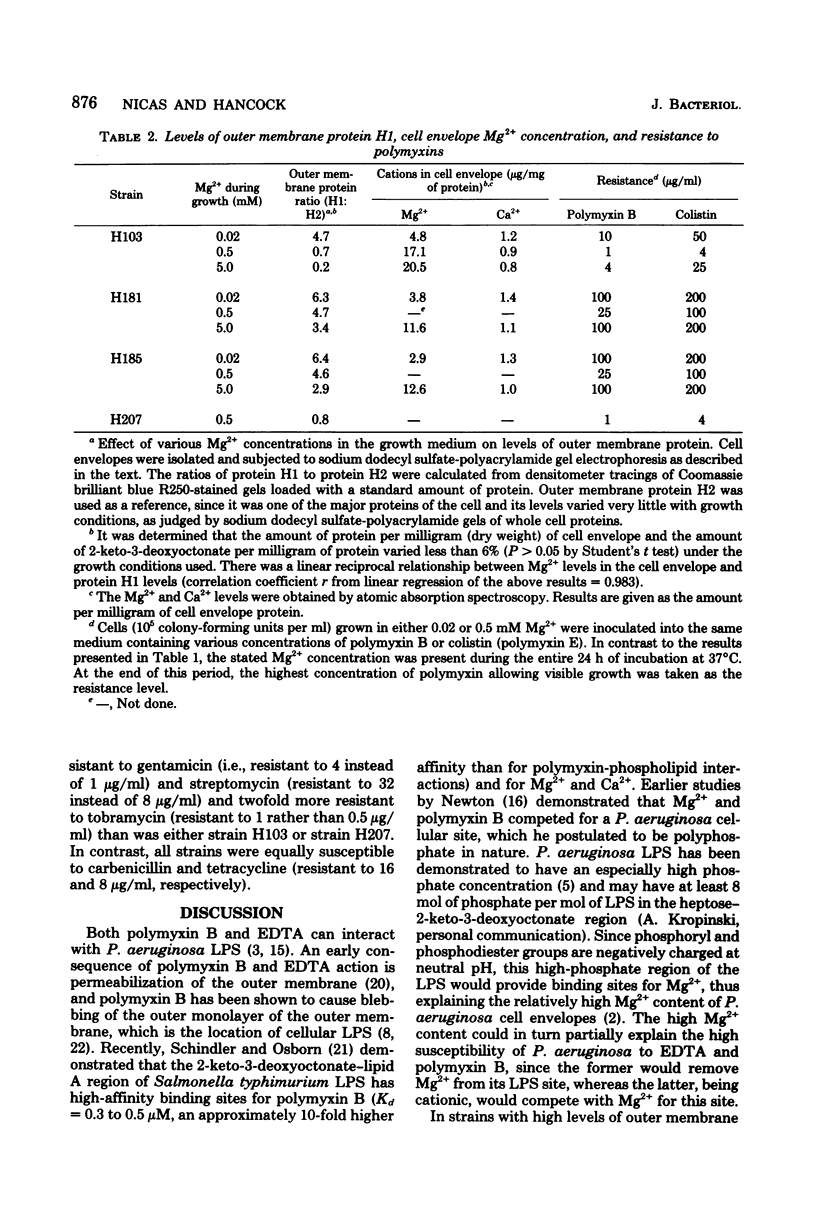Abstract
It is well established that Pseudomonas aeruginosa cells grown in Mg2+-deficient medium acquire nonmutational resistance to the chelator ethylenediaminetetraacetate and to the cationic antibiotic polymyxin B; this type of resistance can be reversed by transferring the cells to Mg2+-sufficient medium for a few generations. Stable mutants resistant to polymyxin B were isolated and shown to have also gained ethylenediaminetetraacetate resistance. Both the mutants and strains grown on Mg2+-deficient medium had greatly enhanced levels of outer membrane protein H1 when compared with the wild-type strain or with revertants grown in Mg2+-sufficient medium. It was determined that in all strains and at all medium Mg2+ concentrations, the cell envelope Mg2+ concentration varied inversely with the amount of protein H1. In addition, the increase in protein H1 in the mutants was associated with an increase in resistance to another group of cationic antibiotics, the aminoglycosides, e.g., gentamicin. We propose that protein H1 acts by replacing Mg2+ at a site on the lipopolysaccharide which can otherwise be attacked by the cationic antibiotics or ethylenediaminetetraacetate.
Full text
PDF






Images in this article
Selected References
These references are in PubMed. This may not be the complete list of references from this article.
- Brown M. R., Melling J. Role of divalent cations in the action of polymyxin B and EDTA on Pseudomonas aeruginosa. J Gen Microbiol. 1969 Dec;59(2):263–274. doi: 10.1099/00221287-59-2-263. [DOI] [PubMed] [Google Scholar]
- Brown M. R., Wood S. M. Relation between cation and lipid content of cell walls of Pseudomonas aeruginosa, Proteus vulgaris and Klebsiella aerogenes and their sensitivity to polymyxin B and other antibacterial agents. J Pharm Pharmacol. 1972 Mar;24(3):215–218. doi: 10.1111/j.2042-7158.1972.tb08967.x. [DOI] [PubMed] [Google Scholar]
- Cooperstock M. S. Inactivation of endotoxin by polymyxin B. Antimicrob Agents Chemother. 1974 Oct;6(4):422–425. doi: 10.1128/aac.6.4.422. [DOI] [PMC free article] [PubMed] [Google Scholar]
- Davis S. D. Dissociation between results of in vitro and in vivo antibiotic susceptibility tests for some strains of Pseudomonas aeruginosa. Antimicrob Agents Chemother. 1974 Mar;5(3):281–288. doi: 10.1128/aac.5.3.281. [DOI] [PMC free article] [PubMed] [Google Scholar]
- Drewry D. T., Gray G. W., Wilkinson S. G. Release of ethanolamine pyrophosphate during mild acid hydrolysis of the lipopolysaccharide of Pseudomonas aeruginosa. Eur J Biochem. 1971 Aug 16;21(3):400–403. doi: 10.1111/j.1432-1033.1971.tb01483.x. [DOI] [PubMed] [Google Scholar]
- Flick M. R., Cluff L. E. Pseudomonas bacteremia. Review of 108 cases. Am J Med. 1976 Apr;60(4):501–508. doi: 10.1016/0002-9343(76)90716-6. [DOI] [PubMed] [Google Scholar]
- Gilleland H. E., Jr, Lyle R. D. Chemical alterations in cell envelopes of polymyxin-resistant Pseudomonas aeruginosa isolates. J Bacteriol. 1979 Jun;138(3):839–845. doi: 10.1128/jb.138.3.839-845.1979. [DOI] [PMC free article] [PubMed] [Google Scholar]
- Gilleland H. E., Jr, Murray R. G. Ultrastructural study of polymyxin-resistant isolates of Pseudomonas aeruginosa. J Bacteriol. 1976 Jan;125(1):267–281. doi: 10.1128/jb.125.1.267-281.1976. [DOI] [PMC free article] [PubMed] [Google Scholar]
- Gilleland H. E., Jr, Stinnett J. D., Eagon R. G. Ultrastructural and chemical alteration of the cell envelope of Pseudomonas aeruginosa, associated with resistance to ethylenediaminetetraacetate resulting from growth in a Mg2+-deficient medium. J Bacteriol. 1974 Jan;117(1):302–311. doi: 10.1128/jb.117.1.302-311.1974. [DOI] [PMC free article] [PubMed] [Google Scholar]
- Hancock R. E., Carey A. M. Outer membrane of Pseudomonas aeruginosa: heat- 2-mercaptoethanol-modifiable proteins. J Bacteriol. 1979 Dec;140(3):902–910. doi: 10.1128/jb.140.3.902-910.1979. [DOI] [PMC free article] [PubMed] [Google Scholar]
- Hancock R. E., Nikaido H. Outer membranes of gram-negative bacteria. XIX. Isolation from Pseudomonas aeruginosa PAO1 and use in reconstitution and definition of the permeability barrier. J Bacteriol. 1978 Oct;136(1):381–390. doi: 10.1128/jb.136.1.381-390.1978. [DOI] [PMC free article] [PubMed] [Google Scholar]
- Hancock R. E., Reeves P. Lipopolysaccharide-deficient, bacteriophage-resistant mutants of Escherichia coli K-12. J Bacteriol. 1976 Jul;127(1):98–108. doi: 10.1128/jb.127.1.98-108.1976. [DOI] [PMC free article] [PubMed] [Google Scholar]
- Kenward M. A., Brown M. R., Hesslewood S. R., Dillon C. Influence of R-plasmid RP1 of Pseudomonas aeruginosa on cell wall composition, drug resistance, and sensitivity to cold shock. Antimicrob Agents Chemother. 1978 Mar;13(3):446–453. doi: 10.1128/aac.13.3.446. [DOI] [PMC free article] [PubMed] [Google Scholar]
- Kropinski A. M., Chan L., Jarrell K., Milazzo F. H. The nature of Pseudomonas aeruginosa strain PAO bacteriophage receptors. Can J Microbiol. 1977 Jun;23(6):653–658. doi: 10.1139/m77-098. [DOI] [PubMed] [Google Scholar]
- Michaels G. B., Eagon R. G. The effect of ethylenediaminetetraacetate and lysozyme on isolated lipopolysaccharide from Pseudomonas aeruginosa. Proc Soc Exp Biol Med. 1966 Jul;122(3):866–868. doi: 10.3181/00379727-122-31273. [DOI] [PubMed] [Google Scholar]
- NEWTON B. A. Site of action of polymyxin on Pseudomonas aeruginosa: antagonism by cations. J Gen Microbiol. 1954 Jun;10(3):491–499. doi: 10.1099/00221287-10-3-491. [DOI] [PubMed] [Google Scholar]
- Paranchych W., Sastry P. A., Frost L. S., Carpenter M., Armstrong G. D., Watts T. H. Biochemical studies on pili isolated from Pseudomonas aeruginosa strain PAO. Can J Microbiol. 1979 Oct;25(10):1175–1181. doi: 10.1139/m79-182. [DOI] [PubMed] [Google Scholar]
- Pechey D. T., James A. M. Surface properties of cells of gentamicin-sensitive and gentamicin-resistant strains of Pseudomonas aeruginosa. Microbios. 1974 Jun-Jul;10A SUPPL(41):111–126. [PubMed] [Google Scholar]
- Rosenthal K. S., Storm D. R. Disruption of the Escherichia coli outer membrane permeability barrier by immobilized polymyxin B. J Antibiot (Tokyo) 1977 Dec;30(12):1087–1092. doi: 10.7164/antibiotics.30.1087. [DOI] [PubMed] [Google Scholar]
- Schindler M., Osborn M. J. Interaction of divalent cations and polymyxin B with lipopolysaccharide. Biochemistry. 1979 Oct 2;18(20):4425–4430. doi: 10.1021/bi00587a024. [DOI] [PubMed] [Google Scholar]
- Schindler P. R., Teuber M. Action of polymyxin B on bacterial membranes: morphological changes in the cytoplasm and in the outer membrane of Salmonella typhimurium and Escherichia coli B. Antimicrob Agents Chemother. 1975 Jul;8(1):95–104. doi: 10.1128/aac.8.1.95. [DOI] [PMC free article] [PubMed] [Google Scholar]
- Zimelis V. M., Jackson G. G. Activity of aminoglycoside antibiotics aganst Pseudomonas aeruginosa: specificity and site of calcium and magnesium antagonism. J Infect Dis. 1973 Jun;127(6):663–669. doi: 10.1093/infdis/127.6.663. [DOI] [PubMed] [Google Scholar]



